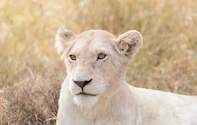
The first person to spot the cubs was James Moir, a member of the Ingwelala shareblock in the Umbabat. He was desperately searching for the "Jacaranda" pride that is known to frequent the area, and stopped at a lookout over the riverbed on May 23, 2006.His patience at the elevated lookout was rewarded when a lioness walked into view, followed by her two small white cubs. After calling in the sighting, he was joined by the conservation manager of Ingwelala, and the two took extensive photos and video footage of the cubs. Other members of the shareblock are now keeping vigilant watch at the lookout, but although the females from the pride have been spotted, the cubs had not been resighted at the time of going to press.According to Errol Pietersen, warden of the Umbabat, the cubs' birthplace is about 15km north, as the crow flies, from the place where the "White Lions of the Timbavati", made famous by Chris McBride in the 1970s and 1980s, occurred.
The Umbabat and Timbavati Private Natures Reserves are adjoining, and white lions have historically been seen in both reserves. Another white male lion was seen in the Kruger National Park (KNP) between Tshokwane and south of the Sabie River in 1992.The birth of the two white cubs proves that white lions are not "extinct in the wild", as claimed by many white lion lovers, but bear out the statement made by Dr Freek Venter, head of conservation services in Kruger, that "white lions will in all probability reappear in the system in time."
Dr Venter made this statement in response to a meeting called by the Global White Lion Protection Trust in April last year, regarding their proposed re-introduction of captive-bred white lions into the general Timbavati region. The park was not in favour of the project, saying, "We do not support this project as having any conservation value."The Trust has recently released a white lioness, known as Marah, and her three subadult white offspring from their confinement in a small boma onto a section of their 600ha farm adjoining the Timbavati Private Nature Reserve. The lions are reportedly doing well in their early attempts to learn hunting skills after a lifetime of captivity.
The Global White Lion Protection Trust has called on environmental affairs minister Marthinus van Schalkwyk to make white lions a specially protected species, and say in their May 2006 newsletter that, "A lot more work needs to be done in reclassifying the white lions as the subspecies, Panthera leo krugeri variety White Lions."However, white lions are not regarded as a separate subspecies by scientists, but are produced by the mating of two tawny lions who both carry a recessive gene for white coat colour. White lions are not albinos, as they have some pigmentation and dark eyes, but are known as leucistic animals. Dr Venter explained the rarity of white lions in the wild, saying "it is likely that these individuals have a disadvantage over normal tawny lions and tend to be selected out, thus making their occurrence in the population a rarity."The last white lion known to live in the wild to almost the full life expectancy of a tawny lion was a white lioness known as "Whitey." Whitey lived to be about 12 years old, and she produced and raised three litters of tawny offspring. According to Mario Cesare, warden of Balule Private Nature Reserve, Whitey was born about five kilometres away from the present white lion cubs, in the vicinity of Motswari lodge. Cesare worked at Motswari for much of Whitey's life, and he says that she was an exceptionally good hunter.As with any wild lions, the future of the new white cubs is uncertain, given that male lions frequently kill cubs when they take over a pride. However, Umbabat warden Errol Pietersen says that the male lion who is thought to be the father of the cubs has been seen hunting with the pride in the last few weeks, and there has been no evidence of a recent takeover in the pride.The lions are not thought to be sired by the so-called "Sohebele males," a coalition of two black maned lions that roamed the Umbabat. One of these lions was recently legally shot on a permit when it ventured onto land that is unfenced with the Umbabat but is not bound by the Umbabat's constitution or the hunting protocols that the reserves adjoining Kruger adhere to. The hunting protocols do not allow for the shooting of lions that are in a dominant coalition due to the disruption that is subsequently caused during pride takeover by new male lions.The Umbabat has said in a press release that, "There are no plans to overly protect or exploit the white lion cubs] in any way. They plan on monitoring their growth and well-being and other than that they will be treated like all the other lions, an integral part of the central lowveld ecosystem and hopefully these cubs will in turn ensure that the white genes they carry will be dispersed into the broader lion community for future generations to enjoy when they are manifested."

